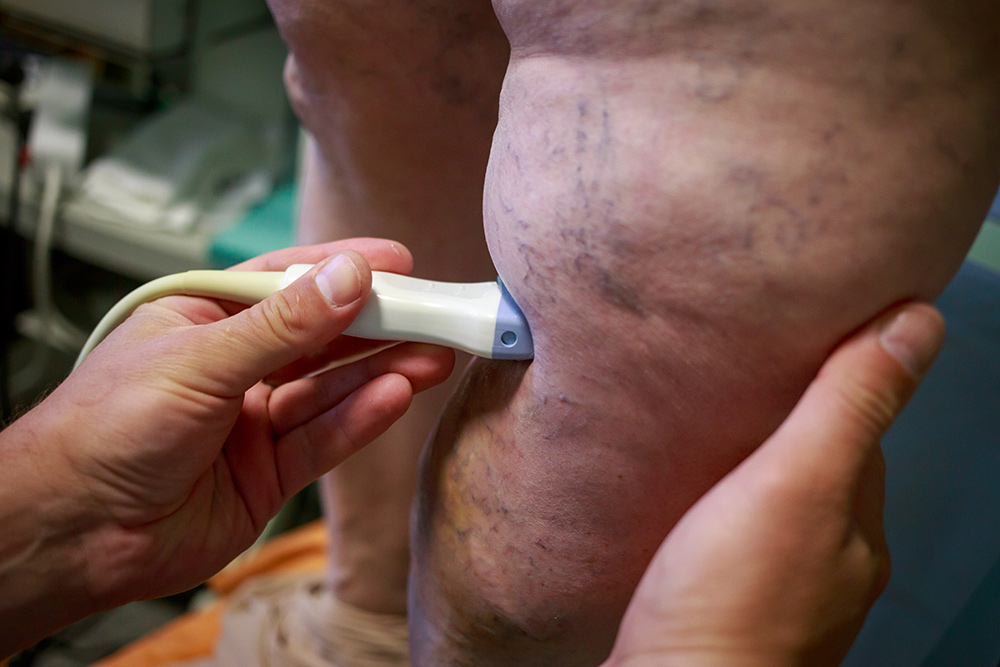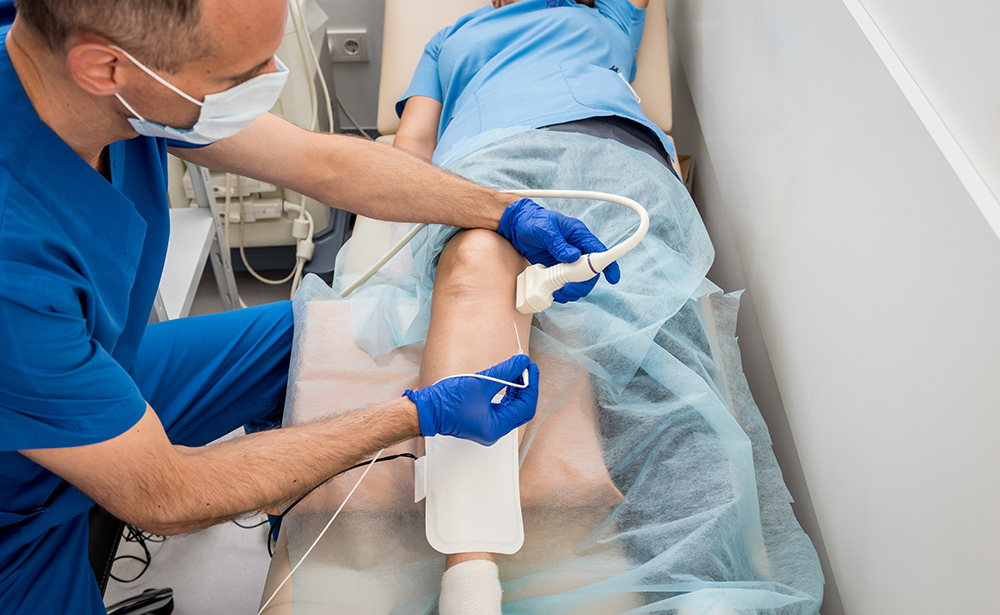Table of Contents
ToggleLast updated on July 22, 2025
When it comes to diagnosing and managing vein or artery conditions, precision is everything. That’s where vascular ultrasound comes in—a non-invasive, painless imaging test that allows doctors to see exactly how your blood is flowing through your arteries and veins. If you’ve ever wondered what a vascular ultrasound is or why you may need a vascular ultrasound, this article will walk you through everything you need to know.
At Vein Doctors Sydney, vascular ultrasound plays a central role in helping us diagnose and treat a wide range of vascular conditions, including varicose veins, deep vein thrombosis (DVT), and chronic venous insufficiency. It also helps us tailor treatments like ultrasound-guided foam sclerotherapy and radiofrequency ablation with incredible accuracy—leading to safer procedures, better outcomes, and faster recoveries.
Overview of a Vascular Ultrasound
A vascular ultrasound is a specialised, non-invasive diagnostic scan that uses high-frequency sound waves (ultrasound) to produce real-time images of the blood vessels in your body. It plays a crucial role in assessing both arteries and veins, helping healthcare providers identify a wide range of vascular conditions.
This test can detect:
- Blood clots (deep vein thrombosis or DVT)
- Narrowing or blockages in the arteries, which may indicate peripheral artery disease (PAD)
- Faulty or leaking vein valves, often seen in patients with varicose veins or venous insufficiency
- Poor circulation or venous reflux, which can lead to swelling, skin changes, or leg ulcers
- Aneurysms or abnormal blood vessel structures, which can pose serious health risks if left untreated
Because it’s completely safe and involves no radiation, vascular ultrasound is suitable for most patients, including those who are pregnant or have chronic health conditions. The scan typically takes between 30 to 60 minutes and is performed using a handheld device (called a transducer) and a water-based gel applied to the skin.
At Vein Doctors Sydney, vascular ultrasound is often the first step in diagnosing a vascular concern. It also guides treatment planning—especially for procedures like ultrasound-guided foam sclerotherapy or uterine fibroid embolisation—to ensure targeted and effective care.

Why Do I Need a Vascular Ultrasound?
Your doctor might refer you for a vascular ultrasound if you’re experiencing:
- Leg swelling or heaviness
- Pain, cramping or numbness in the limbs
- Visible varicose or spider veins
- Skin changes or ulcers on the legs or ankles
- Previous blood clots or DVT
- A history of vascular disease
This type of imaging helps us see what’s going on inside your blood vessels in real time. At Vein Doctors Sydney, we use this scan not only for diagnosis, but also as part of our treatment process. The ultrasound ensures we’re treating the right vein, in the right location, with maximum precision.
What to Expect During the Procedure
A vascular ultrasound is a straightforward, non-invasive procedure that doesn’t involve needles, radiation, or contrast dyes. It’s generally well-tolerated and comfortable, making it a preferred diagnostic tool for assessing vein and artery health. Here’s what typically happens during the scan:
1. Positioning
You’ll be asked to lie down on an examination table. Depending on the area being examined—commonly the legs, abdomen, or neck—you may need to adjust positions during the scan to allow for better imaging access.
2. Gel Application
A clear, water-based gel is applied to the skin over the target area. This gel helps transmit the ultrasound waves effectively and allows the probe to glide smoothly across the skin.
3. Scanning
The sonographer will gently move a handheld transducer (probe) across your skin. This device sends high-frequency sound waves into the body and captures the echoes as they bounce off your blood vessels. These echoes are then converted into real-time images that appear on a monitor.
4. Image Capture and Evaluation
During the scan, the sonographer may ask you to hold your breath, shift position, or contract certain muscles to get clearer images. In some cases, gentle pressure may be applied to check for vein compressibility or blood flow. The captured images are saved for review.
5. Review and Results
Once the scan is complete, your vascular specialist will review the images and assess blood flow, identify any blockages, clots, or valve dysfunction, and determine the presence of conditions like varicose veins or DVT. The findings will then be discussed with you, along with any recommended treatment or further testing.
The entire procedure usually takes between 30 to 60 minutes, and there’s no downtime—you can return to your normal routine immediately afterward. At Vein Doctors Sydney, we prioritise patient comfort and precision, ensuring you receive a thorough assessment using advanced vascular imaging techniques.

A vascular ultrasound is a pretty straightforward procedure that’s non-invasive and is generally well-tolerated and comfortable.
How Vascular Ultrasound Supports Treatment at Vein Doctors Sydney
At Vein Doctors Sydney, vascular ultrasound is integrated into every stage of care—from initial assessment to live-guided treatment and ongoing monitoring. We use this technology to:
- Map abnormal veins and assess the severity of reflux
- Guide precision treatment like foam sclerotherapy or radiofrequency ablation
- Monitor recovery and ensure veins are responding to therapy
- Reduce the need for exploratory procedures or general anaesthetic
This means less guesswork, faster procedures, and better long-term results. Our highly trained team ensures every ultrasound is performed with skill and accuracy, using state-of-the-art equipment.
How to Book an Appointment
At Vein Doctors Sydney, we are committed to providing personalised and compassionate care for patients seeking relief from a wide range of vascular conditions. For more information on our services or to schedule a consultation at our clinic, please contact our friendly staff by either calling us on (02) 9023 9970, via our online form or by sending us an email.
Frequently Asked Questions
What is a vascular ultrasound used for?
A vascular ultrasound is primarily used to assess blood flow in the veins and arteries. It helps detect problems such as blocked or narrowed blood vessels, blood clots (like deep vein thrombosis), varicose veins, or signs of poor circulation. In many cases, it is also used to guide treatment, such as ultrasound-guided sclerotherapy, or to monitor recovery after a vascular procedure. It provides real-time information that helps clinicians make accurate and timely decisions.
Why do I need a vascular ultrasound?
You may be referred for a vascular ultrasound if you’re experiencing symptoms like leg swelling, pain, heaviness, varicose veins, or skin changes. It can also be recommended if there’s a history of blood clots, or if your doctor suspects poor circulation or venous insufficiency. The scan helps pinpoint the cause of your symptoms and allows for a tailored treatment plan that addresses the underlying issue, not just the visible signs.
Is a vascular ultrasound safe?
Yes, vascular ultrasound is completely safe. It is a non-invasive test that uses harmless high-frequency sound waves to produce images—there’s no radiation exposure involved. Because of its excellent safety profile, it’s commonly used for patients of all ages, including pregnant women. At Vein Doctors Sydney, we use the latest ultrasound technology to ensure clear results with maximum comfort.
Does a vascular ultrasound hurt?
Not at all. A vascular ultrasound is painless and generally well-tolerated. You may feel slight pressure as the technician glides the handheld probe (transducer) over your skin, but it’s not uncomfortable. The gel applied to your skin may feel cool initially, but there’s no recovery time needed, and you can go about your day immediately after the scan.
How long does a vascular ultrasound take?
A typical vascular ultrasound takes between 30 and 60 minutes to complete, depending on the area being scanned and the complexity of the case. During this time, the sonographer will carefully examine the blood flow and look for any abnormalities. Once the test is finished, the results are reviewed by your specialist to determine the best course of action.
This information is not intended to be used for diagnosis or treatment. It is aimed at presenting a perspective only and is not a substitute for a prescription. Anyone experiencing a medical condition should consult their doctor.

